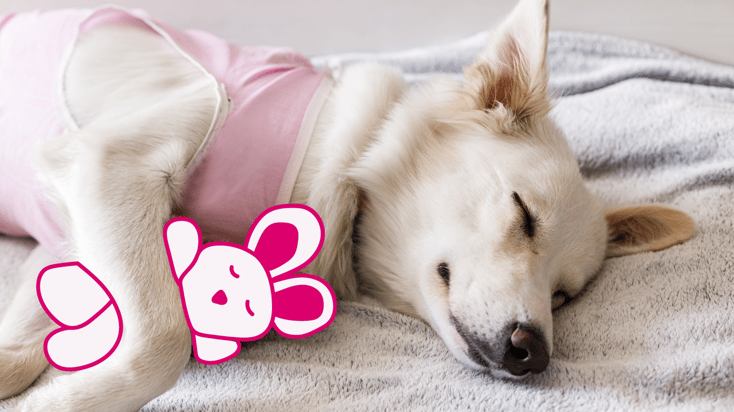Taking Care of Post-Surgery Stitches in Dogs

Table of Contents
If your dog has recently had surgery, whether it was a neuter or spay incision or another surgical procedure requiring stitches, there are important measures that you can take as a pet parent to prevent complications and help your dog heal.
As a veterinarian, I recommend these seven steps to ensure a smooth recovery for your furry friend:
1. Follow Your Veterinarian’s Post-Care Instructions
Depending on your dog’s procedure, your veterinarian will provide instructions about caring for your dog’s stitches and incision area. Ask for written instructions that you can refer to later.
Schedule a follow-up appointment if recommended by your veterinary team. BetterVet offers in-home follow-up visits and telemedicine, so you don’t have to transport your pet during their recovery.
Virtual Vet Visits for Your Peace of Mind
Connect with an online vet from the comfort of your home. Convenient, affordable, and stress-free!
2. Keep the Incision Area Clean and Dry
Another reminder I regularly give to pet parents is to keep the incision area clean and dry to reduce the risk of infection.
Refrain from bathing your pet until the stitches have been removed or when given the go-ahead by your veterinarian.
3. Give Your Dog All Prescribed Medications
If your veterinarian has prescribed medications such as pain relievers or antibiotics, make sure to give them to your dog as directed.
It’s important to complete the entire course of the medications, even if your dog is feeling better, as this will help prevent infections and manage discomfort.
If your dog continues to be uncomfortable, even after being given pain relievers, you may want to schedule a follow-up visit with your veterinarian.
4. Limit Your Dog’s Activity
It is also important to your dog’s recovery to restrict their activity level for 7 to 14 days during the initial healing period. Avoid activities that could strain or reopen the incision, like running, jumping, or roughhousing.
When you do take your dog outside to potty, keep them on a short leash for a brief walk only. Provide a calm environment to help your dog rest.
If your dog has a high activity level, using a crate to encourage quiet time, keeping them on a leash in the house, or calming sedatives may help.
Prescription Trazodone Dosage for Dogs
Prescription Trazodone Dosage for Dogs
View Results
Your Pet's Results
The suggested Trazodone dosage range for your dog is , taken by mouth.
While Trazodone is not FDA-approved for use in dogs, it is commonly prescribed for off-label use. Share the results of your dog’s dosage recommendation with your veterinarian and discuss whether Trazodone is a good choice for them.
The content of this quiz was medically reviewed by Dr. Lyndsey Kingsley. This quiz is not meant to take the place of a medical diagnosis from a veterinary doctor.
Share Quiz
5. Use a Cone or Surgery Suit
Prevent your dog from licking, chewing, or scratching their stitches using a cone, also known as an Elizabethan collar or a surgery suit.
Depending on the location of your dog’s incision, your veterinarian will recommend the best product for your pet.
6. Check Your Pet’s Stitches Daily
Monitor the healing process by checking daily for signs of infection and other complications, such as missing stitches.
Some common signs of infection include:
- Dark pink or red skin around the stitches
- Swelling and inflammation
- Discharge or pus
- Foul smell
- Stiffness or discomfort
- Reluctance to move around
- Decreased appetite
- Vomiting and diarrhea
7. Consult Your Veterinarian With Any Questions or Concerns
Even with this checklist on hand, you may still have concerns about your dog’s comfort level or progress.
It’s normal to worry about your pet when they are recovering from surgery, even if it was a minor procedure.
Your BetterVet care team is here to provide guidance, and no question is ever too small. In-home and telemedicine visits are great options for recovering pets, and same-day appointments are available in most locations when your questions can’t wait.
Hassle-free In-Home Pet Sick Visits
When your pet isn't feeling well, the last thing you want is a stressful trip to the vet. Our in-home sick pet visits offer a calm, stress-free alternative.
Conclusion
While it might be a lot of work for pet parents, if you follow these seven steps, your dog’s healing process should be a smooth one.
We want to ensure that your pet is as comfortable as possible and is recovering well from their procedure, so don’t hesitate to reach out with any questions or concerns.
Frequently Asked Questions
How do you keep a dog from licking stitches without a cone?
There are some great inflatable and fabric cones that might be more comfortable for your pet than a traditional plastic cone. Surgery suits (think zip-up pajamas for dogs) are another great option to consider.
Should I put anything on my dog's stitches?
You should not put anything on your dog’s stitches unless prescribed by a veterinarian.
How long do dog stitches take to heal?
With most incisions, dog stitches’ healing time typically ranges from 10-14 days.
How can I make my dog’s stitches heal faster?
I recommend following the seven steps outlined in this post and consulting a veterinarian to determine if and when follow-up care is needed.
What can I put on my dog's stitches to stop itching?
Canine stitches can be very itchy during the healing process, but if they seem very uncomfortable, your veterinarian may prescribe medication to bring them some relief.






